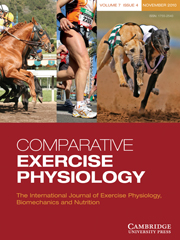Crossref Citations
This article has been cited by the following publications. This list is generated based on data provided by
Crossref.
Kitaoka, Yu
Masuda, Hiroyuki
Mukai, Kazutaka
Hiraga, Atsushi
Takemasa, Tohru
and
Hatta, Hideo
2011.
Effect of training and detraining on monocarboxylate transporter (MCT) 1 and MCT4 in Thoroughbred horses.
Experimental Physiology,
Vol. 96,
Issue. 3,
p.
348.
Kitaoka, Yu
Hoshino, Daisuke
and
Hatta, Hideo
2012.
Monocarboxylate transporter and lactate metabolism.
The Journal of Physical Fitness and Sports Medicine,
Vol. 1,
Issue. 2,
p.
247.
HOSHINO, Daisuke
HANAWA, Tatsuya
TAKAHASHI, Yumiko
MASUDA, Hiroyuki
KATO, Mai
and
HATTA, Hideo
2014.
Chronic Post-Exercise Lactate Administration with Endurance Training Increases Glycogen Concentration and Monocarboxylate Transporter 1 Protein in Mouse White Muscle.
Journal of Nutritional Science and Vitaminology,
Vol. 60,
Issue. 6,
p.
413.
Kitaoka, Yu
Endo, Yukari
Mukai, Kazutaka
Aida, Hiroko
Hiraga, Atsushi
and
Hatta, Hideo
2014.
Muscle glycogen breakdown and lactate metabolism during intensive exercise in Thoroughbred horses.
The Journal of Physical Fitness and Sports Medicine,
Vol. 3,
Issue. 4,
p.
451.
HIRAGA, Atsushi
and
SUGANO, Shigeru
2016.
Studies on exercise physiology of the racehorse performed in Japan during the period from the 1930s to the 1970s: respiration and heart rate during exercise and the effect of exercise on blood characteristics.
Journal of Equine Science,
Vol. 27,
Issue. 2,
p.
37.
Takahashi, Kenya
Kitaoka, Yu
Matsunaga, Yutaka
and
Hatta, Hideo
2019.
Effects of lactate administration on mitochondrial enzyme activity and monocarboxylate transporters in mouse skeletal muscle.
Physiological Reports,
Vol. 7,
Issue. 17,
Wang, Wenxin
Mukai, Kazutaka
Takahashi, Kenya
Ohmura, Hajime
Takahashi, Toshiyuki
Hatta, Hideo
and
Kitaoka, Yu
2020.
Short‐term hypoxic training increases monocarboxylate transporter 4 and phosphofructokinase activity in Thoroughbreds.
Physiological Reports,
Vol. 8,
Issue. 11,
Mukai, Kazutaka
Kitaoka, Yu
Takahashi, Yuji
Takahashi, Toshiyuki
Takahashi, Kenya
and
Ohmura, Hajime
2021.
Moderate‐intensity training in hypoxia improves exercise performance and glycolytic capacity of skeletal muscle in horses.
Physiological Reports,
Vol. 9,
Issue. 23,
Feringer-Júnior, Walter Heinz
de Carvalho, Júlia Ribeiro Garcia
Moranza, Henriette Gellert
de Almeida, Maria Luiza Mendes
Lemos, Eliana Gertrudes Macedo
Soares, Otávio Augusto Brioschi
Ribeiro, Gesiane
and
de Camargo Ferraz, Guilherme
2022.
Cost of transport, but not gluteus medius and red blood cells monocarboxylate-transporters density differentiated Brazilian Sport Horses at two performance levels.
Research in Veterinary Science,
Vol. 143,
Issue. ,
p.
20.
Kitaoka, Yu
Takahashi, Kenya
and
Hatta, Hideo
2022.
Inhibition of monocarboxylate transporters (MCT) 1 and 4 reduces exercise capacity in mice.
Physiological Reports,
Vol. 10,
Issue. 17,
Katz, Lisa M.
2024.
Equine Sports Medicine and Surgery.
p.
95.

